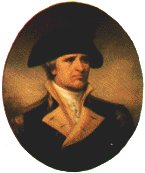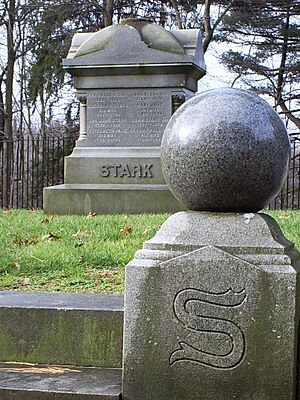John Stark facts for kids
Quick facts for kids
John Stark
|
|
|---|---|
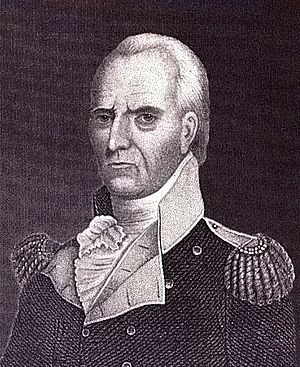 |
|
| Nickname(s) | The Hero of Bennington |
| Born | August 28, 1728 Londonderry, Province of New Hampshire |
| Died | May 8, 1822 (aged 93) Manchester, New Hampshire, United States |
| Place of burial |
Stark Cemetery, Manchester
(43°00′51″N 71°28′15″W / 43.01420°N 71.47095°W) |
| Allegiance | |
| Service/ |
|
| Years of service | 1775–1783 |
| Rank | |
| Unit | Roger's Rangers Continental Army |
| Commands held | Northern Department New Hampshire Militia 1st New Hampshire Regiment |
| Battles/wars | French and Indian War |
John Stark (born August 28, 1728 – died May 8, 1822) was an important American military leader. He fought in two major wars: the French and Indian War and the American Revolutionary War. He is especially remembered as the "Hero of Bennington" for his brave actions at the Battle of Bennington in 1777.
Contents
Early Life and Adventures
John Stark was born in Londonderry, New Hampshire, in 1728. When he was eight, his family moved to Derryfield, which is now Manchester, New Hampshire. He lived there for the rest of his life. John married Elizabeth "Molly" Page and they had 11 children together.
In 1752, while on a hunting trip, John was captured by Abenaki warriors. Before being taken, he warned his brother to escape in their canoe. Another friend, David Stinson, was killed.
While a prisoner, John and another captive, Amos Eastman, were forced to run a gauntlet. This meant running between two lines of warriors armed with sticks. John surprised everyone by grabbing a stick from the first warrior and fighting back! The chief was so impressed by his courage that John was adopted into the tribe. He spent the winter with them.
The next spring, a government agent paid a ransom for John and Amos. They then returned safely to New Hampshire.
Fighting in the French and Indian War
John Stark became a second lieutenant under Major Robert Rogers during the French and Indian War. His brother, William Stark, also served with him. John was part of a famous group called Rogers' Rangers. This experience taught him a lot about fighting and surviving in the wilderness.
In 1757, while with the Rangers, John was on a scouting mission near Fort Carillon. His group was ambushed in a fight known as the Battle on Snowshoes (1757).
Later, in 1759, General Jeffery Amherst ordered Rogers' Rangers to attack an Abenaki village in Quebec. John Stark, who was second-in-command, refused to go. He did this out of respect for his Native American foster-parents who lived there. He then returned home to his wife.
After the war, John retired as a captain. He went back to his home in Derryfield, New Hampshire. His time with the Rangers taught him valuable skills he would use later in the American Revolution.
The American Revolution Begins
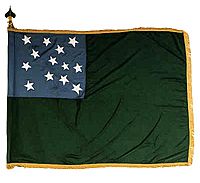
The Battles of Lexington and Concord in April 1775 started the American Revolutionary War. John Stark quickly rejoined the military. On April 23, 1775, he became a colonel in the New Hampshire Militia. He took command of the 1st New Hampshire Regiment.
Stark quickly gathered his men and marched them to Boston. They went to help the American rebels who were surrounded there. He set up his headquarters in a house in Medford, Massachusetts.
The Battle of Bunker Hill
On June 16, 1775, the rebels decided to take and hold Breed's Hill near Boston. They started digging trenches there during the night. At dawn on June 17, British ships saw the activity and began firing. British General Thomas Gage knew he had to remove the rebels. He ordered Major General William Howe to prepare his troops. This began the Battle of Bunker Hill.
American Colonel William Prescott held the hill with only a few hundred militia. He was outnumbered and outgunned, so he asked for more soldiers. Stark and his New Hampshire minutemen arrived soon after. British artillery was firing heavily at Charlestown Neck, a narrow strip of land. Many soldiers were afraid to cross it. Stark calmly marched his men through the fire without any casualties.
When they arrived, Colonel Prescott let Stark place his men where he thought best. Stark saw that the British might try to attack from the beach near the Mystic River. He led his men to that low ground. They quickly built a simple defense line using a fence, straw, grass, and piled rocks. Stark placed his men three deep behind this wall.
A large group of British soldiers, including the Royal Welch Fusiliers, attacked. Stark's men waited until the British were very close. Then, they fired a powerful volley, killing many and stopping the attack. The British retreated. Two more British charges were also pushed back with heavy losses. The British then decided to attack from a different spot.
Later in the battle, as the Americans were forced to retreat, Stark's regiment provided cover fire. This helped Colonel Prescott's troops escape safely.
Even though the British eventually took the hill, they suffered huge losses. After General George Washington arrived, the fight around Boston stopped for a while. In March of the next year, cannons captured from Capture of Fort Ticonderoga were placed on Dorchester Heights. This forced the British to leave Boston and sail to Halifax.
One notable officer who served under Stark was Captain Henry Dearborn. He later became Secretary of War.
Trenton and Princeton Victories
General Washington needed experienced leaders like John Stark for the Continental Army. He offered Stark a command, and Stark accepted. His New Hampshire regiment joined the Continental Army. They were sent to help in the invasion of Canada in 1776. After a retreat, Stark and his men joined Washington's main army in New Jersey. They fought with Washington in the important battles of Princeton and Trenton in late 1776 and early 1777.
After these victories, Washington asked Stark to go back to New Hampshire. His job was to recruit more men for the army. Stark agreed. However, when he got home, he learned that another New Hampshire colonel, Enoch Poor, had been promoted to brigadier general. Stark felt that Poor had not been as brave or experienced as he was. Because of this, Stark resigned his commission on March 23, 1777. But he promised to help New Hampshire if they ever needed him.
The Hero of Bennington
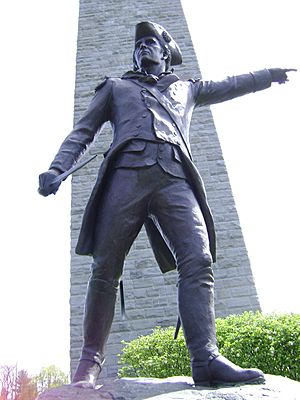
Four months later, New Hampshire asked Stark to become a brigadier general of the New Hampshire Militia. He agreed, but only if he did not have to report to the Continental Army.
Soon after, Stark gathered 1,492 militiamen. They were regular citizens with their own guns. He marched them to Manchester, Vermont. There, he was ordered to join another general's army. But Stark refused, feeling this general was also unfairly promoted. Instead, he decided to fight against General John Burgoyne's British army on his own.
Burgoyne sent a group of soldiers under Lieutenant Colonel Friedrich Baum to capture American supplies in Bennington, Vermont. Baum had about 374 German soldiers, plus Native Americans, Loyalists, and Canadians. Stark heard about this plan and marched his forces to Bennington.
On August 14, Baum asked Burgoyne for more soldiers. He felt confident, but he also built up his defenses. Colonel Seth Warner also set out with 350 men to help Stark.
After a day of rain, on August 16, Stark attacked. He sent groups of his militia to surround Baum's forces. The Native Americans, Loyalists, and Canadians quickly ran away. This left Baum trapped. As his plan worked, Stark led his remaining 1,200 troops against Baum. He famously said, "We'll beat them before night or Molly Stark's a widow."
After an ammunition wagon exploded, Baum's men tried to fight their way out. Baum was badly wounded and his men surrendered around 5:00 PM. Just as Stark's men were celebrating, another group of German soldiers arrived. But then, Colonel Seth Warner's 350 Green Mountain Boys appeared and helped Stark. Together, they stopped the Germans and forced them to retreat.
Stark's victory at Bennington was very important. It greatly boosted American morale. It also stopped the British from getting needed supplies and weakened Burgoyne's army. Stark reported only 14 killed and 42 wounded. For this great success, John Stark was finally promoted to brigadier general in the Continental Army on October 4, 1777.
The Battles of Saratoga, which Bennington helped set up, are seen as a turning point in the war. It was the first major defeat for a British general. It also convinced the French that the Americans could win, leading them to offer military aid.
John Stark also served as a judge in the court martial of British Major John André in 1780. André was found guilty of spying and helping Benedict Arnold try to surrender West Point to the British. Stark commanded the Northern Department of the army three times between 1778 and 1781. He also led a brigade at the Battle of Springfield in June 1780.
Later Years and Legacy
After serving bravely through the rest of the war, John Stark retired to his farm. His town, Derryfield, was renamed Manchester in 1810. He died there on May 8, 1822, at the age of 93.
In 1809, a group of Bennington veterans gathered to remember the battle. General Stark, who was 81 and too ill to travel, sent a letter. It ended with the famous words: "Live free or die: Death is not the worst of evils." This powerful phrase became the official motto of New Hampshire in 1945.
John Stark and the Battle of Bennington are honored by the Bennington Battle Monument. This monument is 306-foot (93 m) tall and stands in Bennington, Vermont. There is also a statue of Stark there.
Historic Sites
- A New Hampshire historical marker (number 48) is near John Stark's birthplace in Derry, New Hampshire. There is also a stone marker at his actual homestead.
- Stark's childhood home is at 2000 Elm Street in Manchester, New Hampshire. His father built it in 1736. The home is now owned by the Molly Stark Chapter of the Daughters of the American Revolution. It is listed on the National Register of Historic Places.
- Stark Park in Manchester is named after him. His grave is located there.
- A bronze statue of General Stark stands in front of the New Hampshire State House in Concord. It was dedicated in 1890.
- Fort Stark in New Castle was renamed for the General in 1900. It was one of seven forts built to protect Portsmouth.
See Also
- Isaac Royall House, Stark's headquarters in Medford, Massachusetts
Many places in the United States are named after John Stark and his wife Molly:
- Fort Stark (New Hampshire)
- John Stark Regional High School (New Hampshire)
- Stark County, Illinois
- Stark County, Ohio
- Stark Mountain (Vermont)
- Stark's Knob (New York)
- Stark, New Hampshire
- Stark, New York
- Starke County, Indiana
- Starksboro, Vermont
- Starkville, Colorado
- Starkville, Georgia
- Starkville, Mississippi
- Starkville, Pennsylvania
- Starkville, New York


